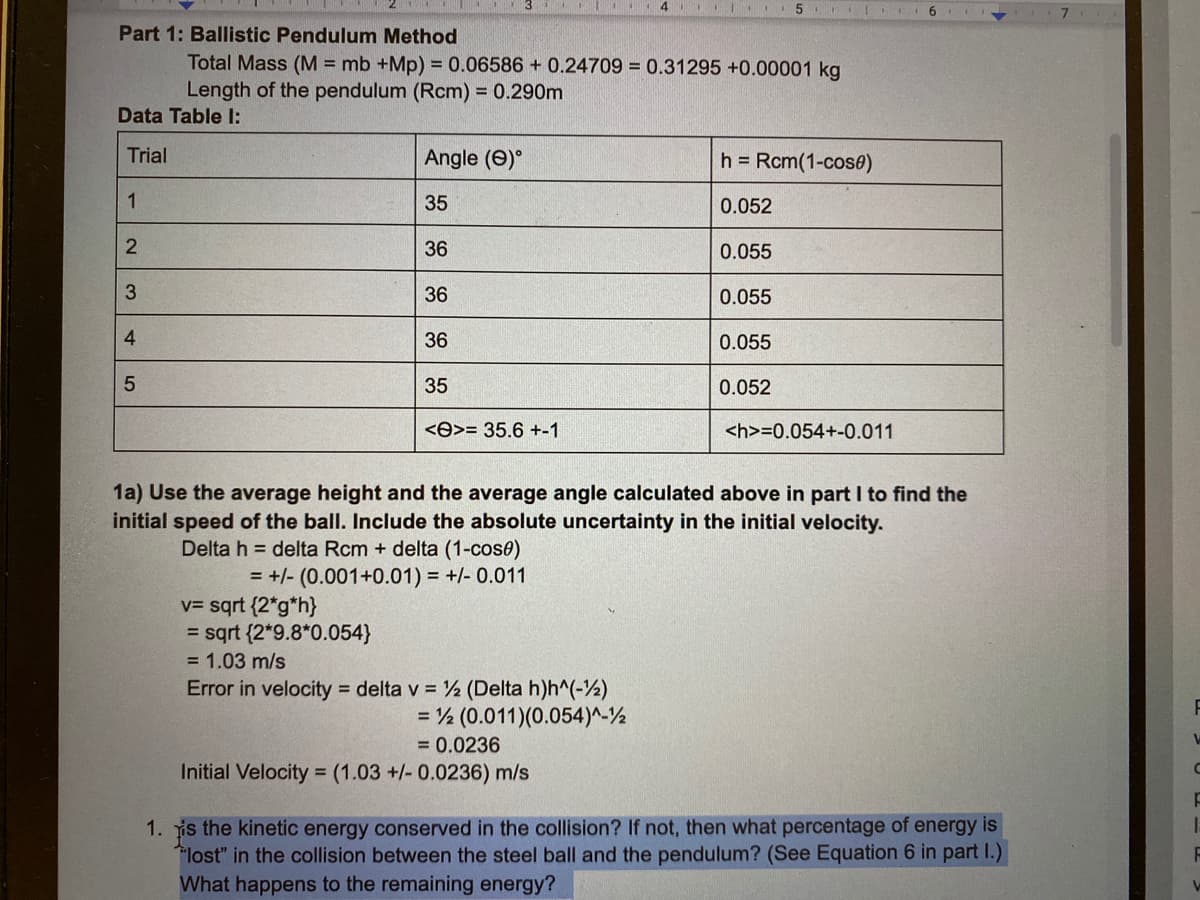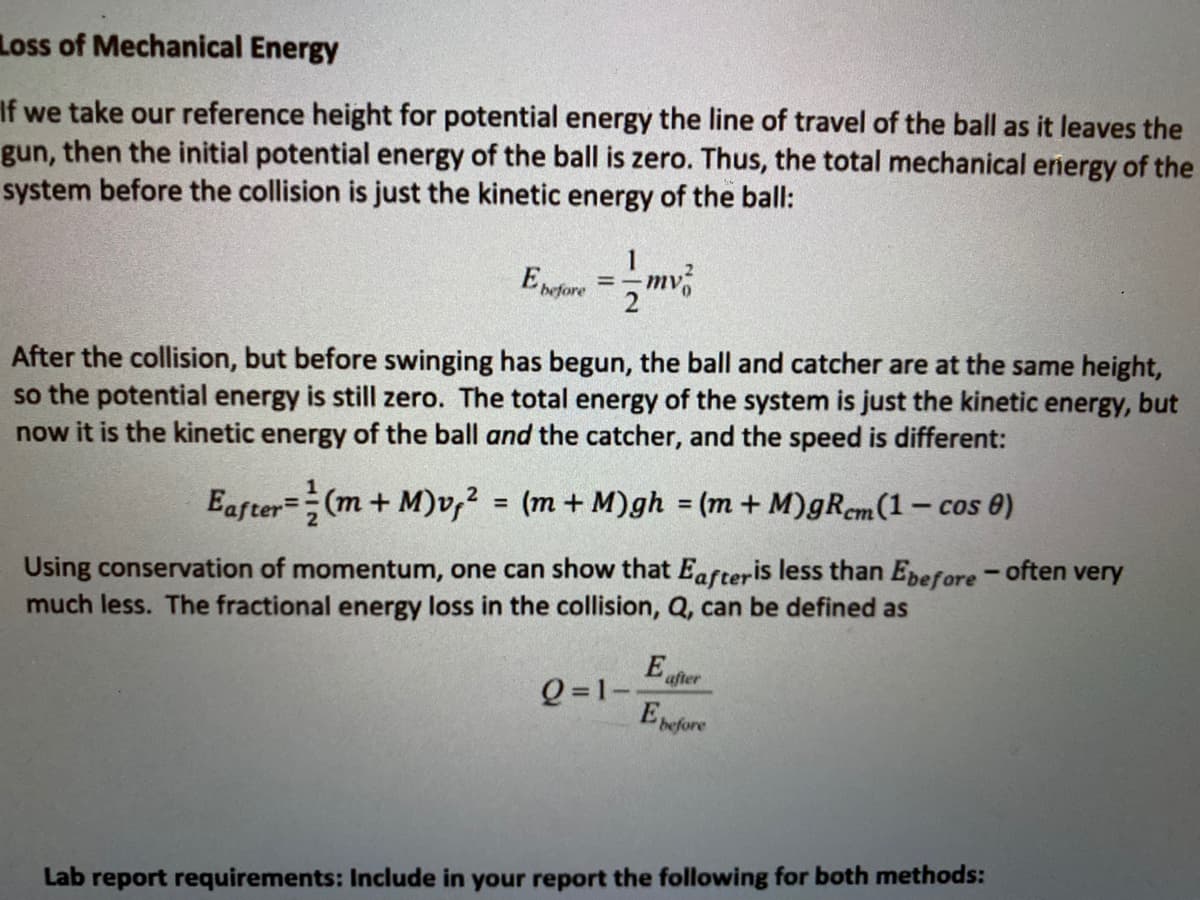Is the kinetic energy conserved in the collision? If not, then what percentage of energy is lost in the collision between the steel ball and the pendulum? (See equation) what happens to remaining energy?
Is the kinetic energy conserved in the collision? If not, then what percentage of energy is lost in the collision between the steel ball and the pendulum? (See equation) what happens to remaining energy?
Physics for Scientists and Engineers: Foundations and Connections
1st Edition
ISBN:9781133939146
Author:Katz, Debora M.
Publisher:Katz, Debora M.
Chapter39: Relativity
Section: Chapter Questions
Problem 1PQ
Related questions
Topic Video
Question
Is the kinetic energy conserved in the collision? If not, then what percentage of energy is lost in the collision between the steel ball and the pendulum? (See equation) what happens to remaining energy?

Transcribed Image Text:4 5 I II L 6
Part 1: Ballistic Pendulum Method
Total Mass (M = mb +Mp) = 0.06586 + 0.24709 = 0.31295 +0.00001 kg
Length of the pendulum (Rcm) = 0.290m
Data Table I:
Trial
Angle (e)°
h = Rcm(1-cose)
1
35
0.052
36
0.055
36
0.055
4.
36
0.055
35
0.052
<O>= 35.6 +-1
<h>=0.054+-0.011
1a) Use the average height and the average angle calculated above in part I to find the
initial speed of the ball. Include the absolute uncertainty in the initial velocity.
Delta h = delta Rcm + delta (1-cose)
= +/- (0.001+0.01) = +/- 0.011
v= sqrt {2*g*h}
= sqrt {2*9.8*0.054}
= 1.03 m/s
Error in velocity = delta v = 2 (Delta h)h^(-2)
%3D
= ½ (0.011)(0.054)^-½
= 0.0236
Initial Velocity = (1.03 +/- 0.0236) m/s
1. s the kinetic energy conserved in the collision? If not, then what percentage of energy is
lost" in the collision between the steel ball and the pendulum? (See Equation 6 in part I.)
What happens to the remaining energy?

Transcribed Image Text:Loss of Mechanical Energy
If we take our reference height for potential energy the line of travel of the ball as it leaves the
gun, then the initial potential energy of the ball is zero. Thus, the total mechanical energy of the
system before the collision is just the kinetic energy of the ball:
%3D
before
After the collision, but before swinging has begun, the ball and catcher are at the same height,
so the potential energy is still zero. The total energy of the system is just the kinetic energy, but
now it is the kinetic energy of the ball and the catcher, and the speed is different:
Eafter=(m+ M)v,? = (m + M)gh = (m + M)gRem(1 – cos e)
%3D
%3D
ст
Using conservation of momentum, one can show that Eafteris less than Epefore - often very
much less. The fractional energy loss in the collision, Q, can be defined as
E
after
Q =1--
Epefore
Lab report requirements: Include in your report the following for both methods:
Expert Solution
This question has been solved!
Explore an expertly crafted, step-by-step solution for a thorough understanding of key concepts.
This is a popular solution!
Trending now
This is a popular solution!
Step by step
Solved in 2 steps with 3 images

Knowledge Booster
Learn more about
Need a deep-dive on the concept behind this application? Look no further. Learn more about this topic, physics and related others by exploring similar questions and additional content below.Recommended textbooks for you

Physics for Scientists and Engineers: Foundations…
Physics
ISBN:
9781133939146
Author:
Katz, Debora M.
Publisher:
Cengage Learning

Physics for Scientists and Engineers: Foundations…
Physics
ISBN:
9781133939146
Author:
Katz, Debora M.
Publisher:
Cengage Learning